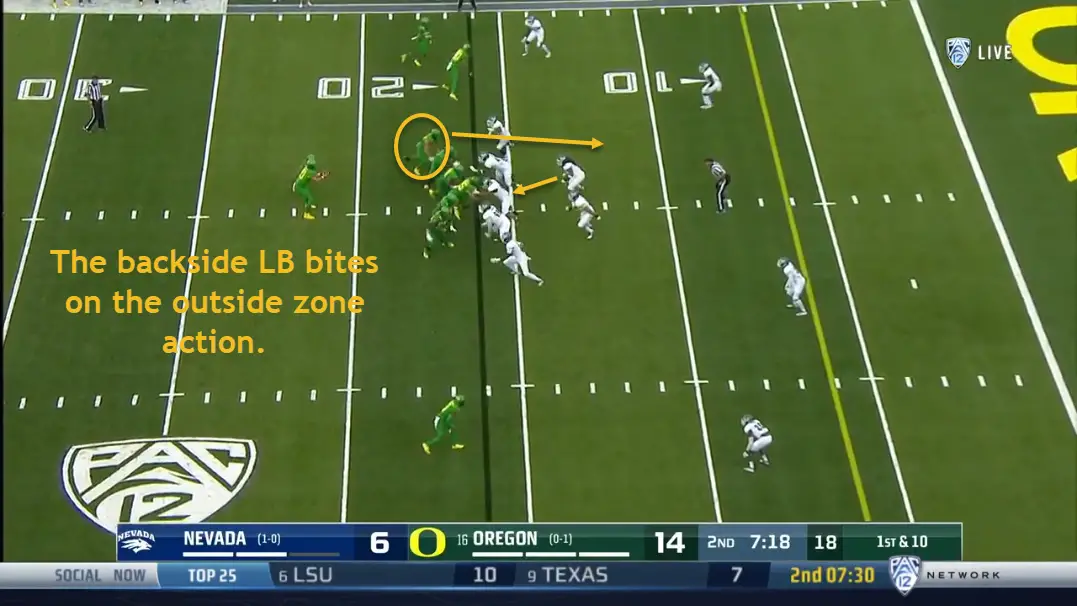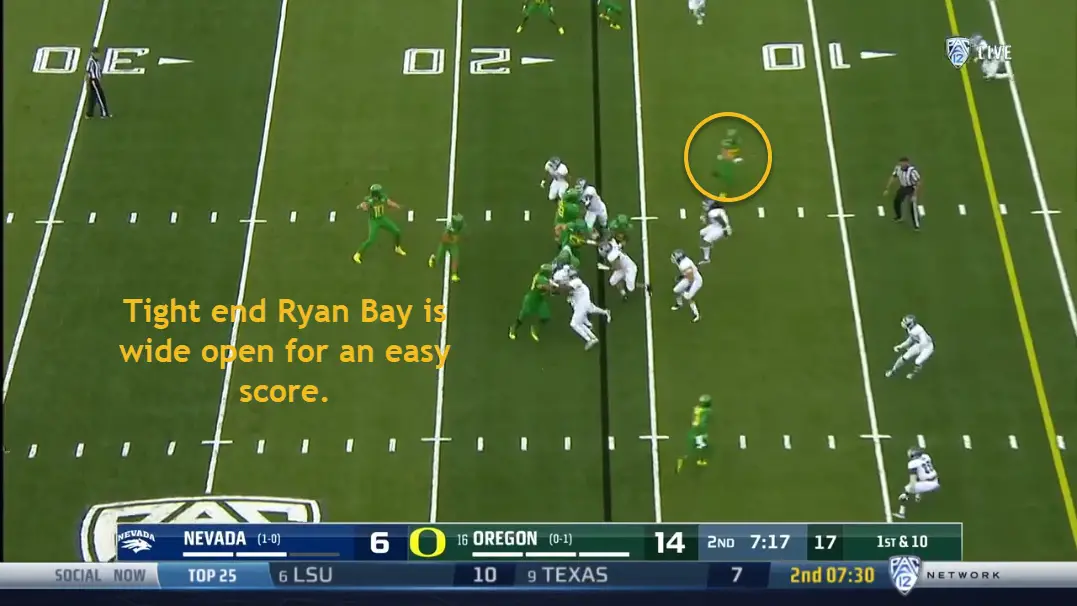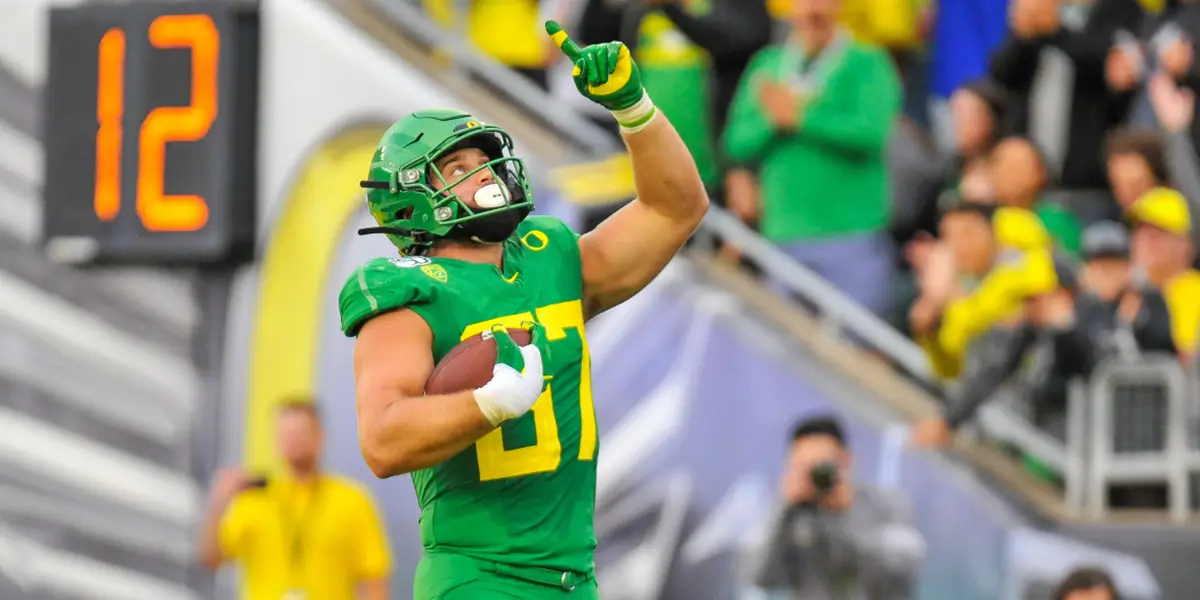To say that Oregon fans were underwhelmed with offensive coordinator Marcus Arroyo’s play calling in the Ducks’ week 1 loss to Auburn would be an understatement. No one shouldered more of the blame for Oregon’s abysmal second half showing — in which the Ducks failed to put up a single point after their first possession — than Arroyo.
But for all the criticism he endured last week, it’s time to give Arroyo credit for opening up the playbook in week 2. Against the Tigers, Oregon showed off a new-look Run-Pass Option (“RPO”) play, as broken down by Coach Eric Boles last week. The play had success at times, especially early, but Auburn’s tight man coverage and second-half adjustments rendered it ineffective as the game wore on. Against Nevada, Arroyo once again utilized outside zone RPOs, but this time, he added a wrinkle — one that will make Oregon’s already explosive offense even more difficult to defend.
The New Outside Zone RPO
Instead of re-engineering his offense entirely, Arroyo predominantly stuck with the same outside zone RPO principles against the Wolf Pack that he used against Auburn. However, on a couple of plays, he made a subtle but significant alteration that added both unpredictability and explosiveness to a staple play.
Instead of running a slant/flat route combination on the backside, as Oregon did in week 1, Arroyo sent the backside tight end on a skinny post or seam route behind the backside linebacker. Meanwhile, the backside receivers ran a quick screen look in order to keep defenders away from the middle of the field. The result was a super easy read for the quarterback, and a nearly impossible play to defend.
In the video above, Oregon lines up in the shotgun formation, with two receivers and a tight end to the boundary (the short side of the field). The play starts like a standard outside zone run, with all of the linemen and the tight end stepping to the right in unison, and quarterback Justin Herbert (No. 10) extending the ball to running back Travis Dye (No. 26).
But as the play unfolds, the tight end on the backside, Ryan Bay (No. 87), abandons his blocking assignment and streaks up the seam. Meanwhile, the defense has completely committed to the run, as Nevada’s backside linebacker, Gabriel Sewell (No. 7), crashes the line of scrimmage.

Standard outside zone action
At this point, Herbert keeps the ball instead of handing off to Dye, noticing the hole in the defensive backfield left by Sewell’s reaction to the run. Herbert lofts a pass to a wide-open Bay, who trots into the end zone for an effortless score.

All too easy …
Notice the backside receivers, who run a perimeter screen look in order to draw defenders away from the middle of the field. This play is designed to isolate the backside linebacker, just like Oregon’s outside zone RPO in week 1. However, this version of the play features a vertical passing route to the tight end as the primary pass option rather than a more conservative slant/flat combination.
In the video above, Oregon runs the same outside zone RPO, this one on fourth down and with a redshirt freshman quarterback. The same rules still apply, and just like last time, the backside linebacker crashes hard toward the line of scrimmage. This makes an easy read for quarterback Tyler Shough (No. 12), who floats a touchdown pass to tight end Hunter Kampmoyer (No. 48).
The “pop pass” (as some refer to this play) to the tight end on RPOs isn’t a new concept throughout college football. But with Oregon’s depth and talent at tight end, and with the Ducks’ lack of explosive plays against Auburn, it was a welcome sign to see the popular play make its way to Arroyo’s offense.
If the Ducks continue to expand their RPO playbook, their offense will make some noise in Pac-12 play this season.
Joshua Whitted
Morgantown, West Virginia Top Photo by Kevin Cline
 Spencer Thomas, the FishDuck.com Volunteer Editor for this article, is an attorney for the Social Security Administration in Atlanta, Georgia, and coaches football at Hillgrove High School in Powder Springs, GA.
Spencer Thomas, the FishDuck.com Volunteer Editor for this article, is an attorney for the Social Security Administration in Atlanta, Georgia, and coaches football at Hillgrove High School in Powder Springs, GA.
Related Articles:
Joshua is an adopted Duck fanatic, originally hailing from southwestern Pennsylvania. His love for the University of Oregon began as a young child when he became mesmerized by the flashy uniforms and explosive offenses of the Chip Kelly era, and now, he follows the team religiously. His fondest memory of the team is seeing De’Anthony Thomas race past Wisconsin defenders back in the 2012 Rose Bowl. A true football enthusiast, Joshua loves studying the intricacies of the game, and he aspires to become a professional sports journalist. Joshua now resides in Morgantown, West Virginia where he works in customer service. When he’s not watching Oregon replays, Joshua loves reading, writing, and spending time with his family. Contact: whittedjd@gmail.com

